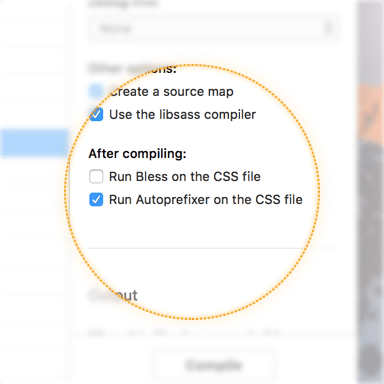

And so, what’s the difference between those or any of the other terms you might hear in this space? So that’s one of the, er, many of the reasons that people use preprocessors-they’re handy, they help you get your job done faster. You can use preprocessors to manage variables and keep you from having to retype the same thing over and over again for consistency. You’re writing something in that preprocessor’s domain-specific language-like Sass has a syntax that you write for. So usually when you’re writing something for a CSS preprocessor, you’re not writing CSS exactly. They also give you lots of handy shortcuts, and as you continue using them, can even give you sort of the ability to do some almost logical work to process your CSS against. And they also help with making CSS work in different browsers. Lyza Danger Gardner: I’ll take that-why not start up here? So, typically when people are using a CSS preprocessor, it allows them to do things that aren’t inherently supported by CSS directly, at least not in all the browsers that people use today. So panelists, what exactly is a preprocessor, and what are the main benefits of using one?


I think there’s a lot of confusion out there about preprocessors, postprocessors, task runners. But why exactly is there pushback in some circles against using tools? So, as our first question, for anyone new to this, we’re going to start with an overview of the terminology. Essentially, it sounds like front-end development requires more than just HTML and CSS.
#CODEKIT AUTOPREFIXER RUNNING SLOW CODE#
So, there’s a lot of discussion these days about tools to help us write code faster and more consistently. And we’re going to start off with a few questions to our panel, and then in the second half we’ll take some of your questions, so the panelists will have a go answering those, too. So, that’s our panelists, and I’ll be moderating, and I’ll be keeping an eye on the questions that you’re asking. Jeff is also a guest lecturer and TA for Ada Developers Academy, and a speaker at Cascadia Fest. Jeff Lembeck is a developer at Filament Group, and a former member of the jQuery mobile team. She specializes in devices and browsers accessing the web globally, and is cofounder of Responsive Field Day 2015. Lyza Danger Gardner is a developer and cofounder of mobile web startup Cloud Four, and is coauthor of the book Head First Mobile Web. She also writes for the Pastry Box and will be a speaker at Future Insights. She’s a freelance front-end developer who focuses on CSS, style guides, responsive, and accessibility. So this is a big topic right now, and even today I saw some tweets on Twitter, someone saying, you know, “Do we need all of this?” And it’s a big topic right now, and there’s a number of pros and cons, so we wanted to have a chat through it. I don’t think anyone would disagree with that.īut there’s also problems inherent in adding complexity, not least in that we make the barrier to entry far higher if people think they need all of this stuff just to get started as a web developer. And there are obvious benefits to using these tools, and obviously they can be a really useful part of our workflow. Many of the tutorials we’re looking at assume a setup that includes a task runner, such as Grunt, and the use of a preprocessor, like Sass, and that’s a sort of standard thing. So, if you take a look at the articles in many web sample applications, it can seem as if it’s just not possible to write only HTML and CSS anymore. So, our topic today is all about tools and workflow. So, check out Pantheon.io to learn how they can fit into your projects. Pantheon provides managed hosting for Drupal and WordPress sites, so you can focus on building websites instead of fiddling around with servers and infrastructure. So, we want to extend a big thank-you to them.
#CODEKIT AUTOPREFIXER RUNNING SLOW SERIES#
Our sponsor for the A List Apart: On Air event series is Pantheon. I’d first just like to mention our sponsor. So, what we’d like to do today is chat with you about some tough questions and try and create the space with a feel of a local web development meetup. So, I’m the moderator for today’s panel and Q&A. I’m one half of the team behind the CMS Perch, and when I started building websites, we didn’t even have CSS. My name is Rachel Andrew and I’m a web developer. Welcome to the second A List Apart: On Air event. Speaker, Future Insights and author, A List Apart Transcript


 0 kommentar(er)
0 kommentar(er)
